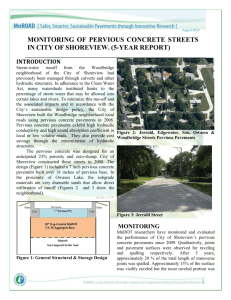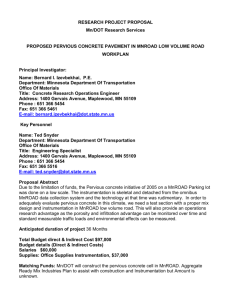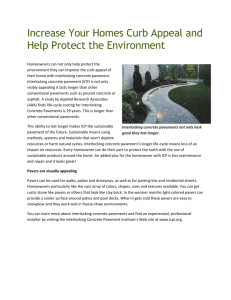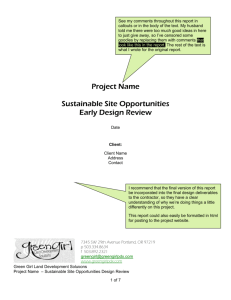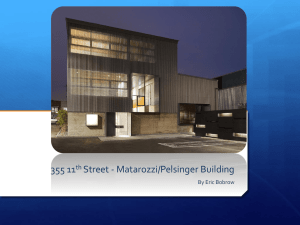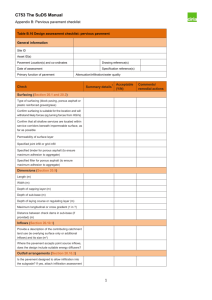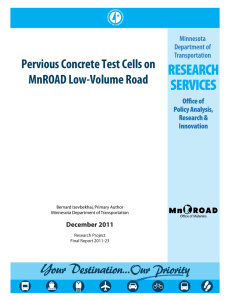2015 MnROAD LVR - Pervious Concrete Performance
advertisement
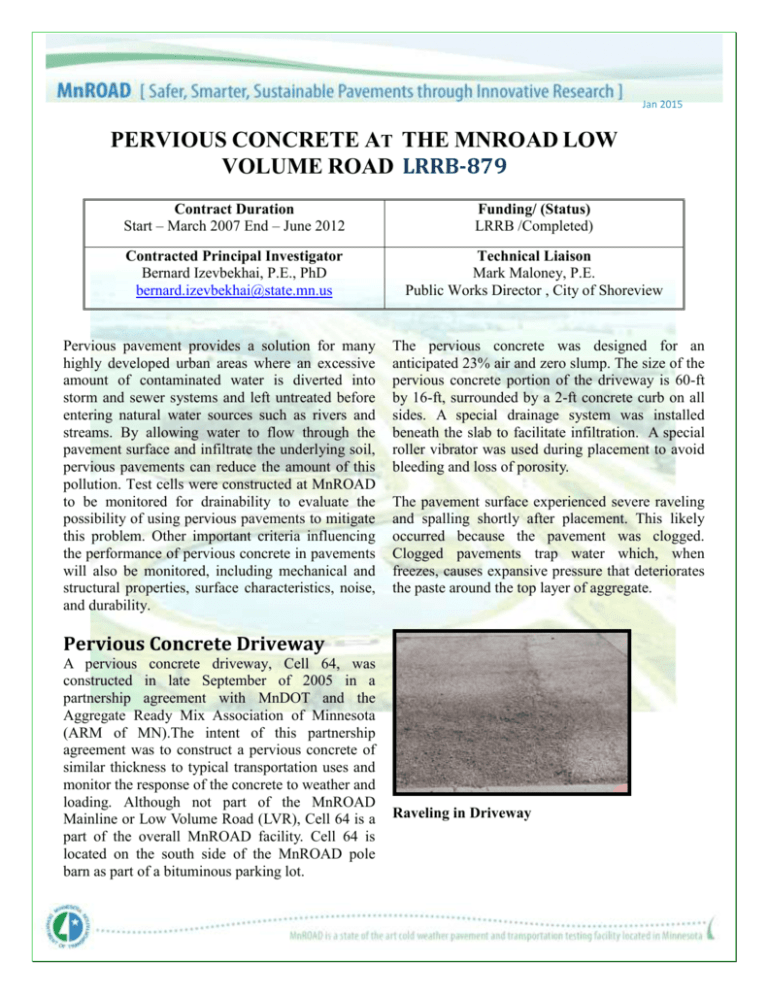
Jan 2015 PERVIOUS CONCRETE AT THE MNROAD LOW VOLUME ROAD LRRB-879 Contract Duration Start – March 2007 End – June 2012 Funding/ (Status) LRRB /Completed) Contracted Principal Investigator Bernard Izevbekhai, P.E., PhD bernard.izevbekhai@state.mn.us Technical Liaison Mark Maloney, P.E. Public Works Director , City of Shoreview Pervious pavement provides a solution for many highly developed urban areas where an excessive amount of contaminated water is diverted into storm and sewer systems and left untreated before entering natural water sources such as rivers and streams. By allowing water to flow through the pavement surface and infiltrate the underlying soil, pervious pavements can reduce the amount of this pollution. Test cells were constructed at MnROAD to be monitored for drainability to evaluate the possibility of using pervious pavements to mitigate this problem. Other important criteria influencing the performance of pervious concrete in pavements will also be monitored, including mechanical and structural properties, surface characteristics, noise, and durability. The pervious concrete was designed for an anticipated 23% air and zero slump. The size of the pervious concrete portion of the driveway is 60-ft by 16-ft, surrounded by a 2-ft concrete curb on all sides. A special drainage system was installed beneath the slab to facilitate infiltration. A special roller vibrator was used during placement to avoid bleeding and loss of porosity. The pavement surface experienced severe raveling and spalling shortly after placement. This likely occurred because the pavement was clogged. Clogged pavements trap water which, when freezes, causes expansive pressure that deteriorates the paste around the top layer of aggregate. Pervious Concrete Driveway A pervious concrete driveway, Cell 64, was constructed in late September of 2005 in a partnership agreement with MnDOT and the Aggregate Ready Mix Association of Minnesota (ARM of MN).The intent of this partnership agreement was to construct a pervious concrete of similar thickness to typical transportation uses and monitor the response of the concrete to weather and loading. Although not part of the MnROAD Mainline or Low Volume Road (LVR), Cell 64 is a part of the overall MnROAD facility. Cell 64 is located on the south side of the MnROAD pole barn as part of a bituminous parking lot. Raveling in Driveway Cells 85 and Cell 89 were full depth reconstruction using the industry standard for pervious concrete. The mix was designed with a porosity between 15 and 18%, unit weight less than 135 pcf, and seven day flexural strength of 300 psi. The difference between the two cells is the full infiltration• scenario with a granular subgrade in cell 85, and a retention system using a cohesive subgrade in cell• 89. The pervious pavement in both cells is 7 inches thick, over 4 inches of railroad ballast and 8 inches of a gap-graded base. The cells are the first at MnROAD to have a curb and gutter system. • th Construction began on October 17 , 2008, using fixed form pavers and roller screed. Each cell was equipped with vibrating wire static strain gauges and thermocouples at various depths to detect• freeze thaw cycles and monitor maturity. The cell was allowed to cure for 28 days using a "Confilm" curing compound and 2 layers of polyethylene sheeting. Ride characteristics, noise characteristics, surface• properties, and physical properties of the two cells were tested immediately after construction, and periodically over the next three years to gain comprehensive understanding of pervious pavement performance. Pervious concrete Research Results ISLAB and similar programs were successfully used to accurately analyze and predict stresses in pervious concrete. Grass Grass Curb 7” Pervious PCC (Industry Spec) Curb 4” RailRoad Ballast 8” Gap-Graded Base 40% Air Voids (Crushed CA-15) Type-V Filter Fabric Subgrade Non-Compacted Cell 85: Granular Cell 89: Cohesive 48” Plastic Barrier Pervious Concrete Test Cells pavements can be designed with traditional methods such as the AASHTO 1993 method or the MEPDG produced pervious concrete pavement which met performance expectations. 48” Plastic Barrier A large longitudinal crack also propagated down the length of the driveway, and was likely a result of FWD testing, traffic, and thermal loading. Data from thermocouple and watermark sensors installed in the pavement suggest that pervious concrete may experience less freeze-thaw cycles than impervious pavements of similar thickness. • When flow testing was done using an in-situ permeability measurement device, results show that sweeping of pervious pavements may lead to clogging and reduced hydraulic conductivity. More importantly, if regular maintenance is not started soon after construction, clogging and damage is irreversible. Vacuuming will not unclog the pores. Knowledge gained from the performance of cell 64 was to be used in the design and construction of two test cells on MnROAD Mainline. X-Section of Pervious Cells Sensors showed reduced temperature gradient throughout the pavement, base and subgrade, and possibly a reduced amount of freeze thaw cycles for full depth pervious concrete. The frequent raveling the pervious cells exhibited is expected to be from freeze thaw distress. Keeping the pavement unclogged can likely lessen the chances for this freeze thaw damage to happen, and therefore reduce raveling. Vacuuming more than two times a year has shown promising results and improved performance. Pervious pavements can be maintained over time with this amount of effort. However, sweeping may cause clogging. Predicting OBSI from sound absorption does not seem feasible at this point. This is likely because sound reduction in pervious pavements come from air compression relief instead of tortuous attenuation. However, it is evident the sound absorption is related to the surface porosity of pervious pavements. Deployment OBSI testing shows pervious concrete is the second quietest surface at MnROAD, second only to the innovative diamond ground concrete. • The pervious test cells show improved sound absorption compared to non-pervious PCC pavement, with the degree of improvement dependent on the sound frequency being tested. Sound absorption at 1000 Hz (closest to tire pavement noise frequency) shows the most improvement. • IRI values were significantly higher than FWHA standards for acceptable pavements. However, all three cells maintained excellent surface ratings. Diamond grinding performed in 2013 significantly reduced IRI from 300 to 80 inches/mile. Ratio of Coefficients • 18 16 14 12 10 8 6 4 2 Ratio of Porous to Non-Porous Sound Absorption Coefficients 300 500 700 900 1100 1300 1500 1700 Frequency (Hz) Porous to Non Porous Bituminous Porous to Non Porous Concrete Acoustic Properties Dissipated Volumetric Rate [cm3/s] Mean Dissipated Volumetric Rate 800 Top: City of Detroit Lakes Pervious Concrete Boat Ramp. 600 400 Middle: City of Rochester Pervious Concrete Shoulder. 200 0 9/08 granular 6/09 10/09 4/10 cohesive Date 9/10 10/10 Drainage Properties Dissipated volumetric rate varied significantly throughout the cells, suggesting uneven material consistency. This flow rate was generally higher in the cell built over sand than the cell built over clay subgrade. Bottom: City of Shoreview Pervious Concrete Street. For More Information: Bernard Igbafen Izevbekhai, P.E., PhD Bernard.Izevbekhai@state.mn.us

